Boston: Difference between revisions
| (One intermediate revision by the same user not shown) | |||
| Line 71: | Line 71: | ||
===17th and 18th centuries=== | ===17th and 18th centuries=== | ||
[[File:Pilgrim Fathers Memorial.JPG|right|thumb|130px|Pilgrim Fathers Memorial]] | [[File:Pilgrim Fathers Memorial.JPG|right|thumb|130px|Pilgrim Fathers Memorial]] | ||
In 1607 a group of pilgrims from Nottinghamshire led by William Brewster and William Bradford attempted to escape pressure to conform to the teaching of the English church by going to the Netherlands from Boston. At that time unsanctioned emigration was illegal, and they were brought before the court in the Guildhall. Most of the pilgrims were released fairly soon and the following year, set sail for the Netherlands, settling in Leiden. In 1620, several of these were among the group who moved to New England in the Mayflower. | In 1607 a group of pilgrims from [[Nottinghamshire]] led by William Brewster and William Bradford attempted to escape pressure to conform to the teaching of the English church by going to the Netherlands from Boston. At that time unsanctioned emigration was illegal, and they were brought before the court in the Guildhall. Most of the pilgrims were released fairly soon and the following year, set sail for the Netherlands, settling in Leiden. In 1620, several of these were among the group who moved to New England in the Mayflower. | ||
Boston remained a hotbed of religious dissent. In 1612 John Cotton became the Vicar of St Botolph's and, although viewed askance by the Church of England for his non-conformist preaching, became responsible for a large increase in Church attendance. He encouraged those who disliked the lack of religious freedom in England to join the Massachusetts Bay Company, and later helped to found the city of Boston, Massachusetts (1630) which he was instrumental in naming. Unable to tolerate the religious situation any longer, he eventually emigrated himself in 1633. | Boston remained a hotbed of religious dissent. In 1612 John Cotton became the Vicar of St Botolph's and, although viewed askance by the Church of England for his non-conformist preaching, became responsible for a large increase in Church attendance. He encouraged those who disliked the lack of religious freedom in England to join the Massachusetts Bay Company, and later helped to found the city of Boston, Massachusetts (1630) which he was instrumental in naming. Unable to tolerate the religious situation any longer, he eventually emigrated himself in 1633. | ||
At the same time, work on draining the fens to the west of Boston was begun, a scheme which displeased many whose livelihoods were at risk. (One of the sources of livelihood obtained from the fen was fowling, supplying ducks and geese for meat and in addition the processing of their feathers and down for use in mattresses and pillows. The feathery aspect of this is still reflected in the presence of the bedding company named Fogarty, located nearby in [[Fishtoft]].) This and the religious friction put Boston into the parliamentarian | At the same time, work on draining the fens to the west of Boston was begun, a scheme which displeased many whose livelihoods were at risk. (One of the sources of livelihood obtained from the fen was fowling, supplying ducks and geese for meat and in addition the processing of their feathers and down for use in mattresses and pillows. The feathery aspect of this is still reflected in the presence of the bedding company named Fogarty, located nearby in [[Fishtoft]].) This and the religious friction put Boston into the parliamentarian camp in the Civil War which in England began in 1642. The chief backer of the drainage locally, Lord Lindsey, was shot in the first battle and the fens returned to their accustomed dampness until after 1750. | ||
The later eighteenth century saw a revival when the Fens began to be effectively drained. The Act of Parliament permitting the embanking and straightening of the fenland Witham was dated 1762. A sluice, called for in the Act, was designed to help scour out The Haven. The land proved to be fertile, and Boston began exporting cereals to London. In 1774 the first financial bank was opened, and in 1776 an Act of Parliament allowed watchmen to begin patrolling the streets at night. | The later eighteenth century saw a revival when the Fens began to be effectively drained. The Act of Parliament permitting the embanking and straightening of the fenland Witham was dated 1762. A sluice, called for in the Act, was designed to help scour out The Haven. The land proved to be fertile, and Boston began exporting cereals to London. In 1774 the first financial bank was opened, and in 1776 an Act of Parliament allowed watchmen to begin patrolling the streets at night. | ||
| Line 118: | Line 118: | ||
[[File:MaudFosterWindmill.JPG|thumb|right|200px|Maude Foster Mill]] | [[File:MaudFosterWindmill.JPG|thumb|right|200px|Maude Foster Mill]] | ||
The seven-storeyed Maud Foster Tower Windmill, completed in 1819, by millwrights Norman & Smithson of [[Kingston upon Hull]] for Issac and Thomas Reckitt, is momentarily the tallest operating [[windmill]] in England (80 ft | The seven-storeyed Maud Foster Tower Windmill, completed in 1819, by millwrights Norman & Smithson of [[Kingston upon Hull]] for Issac and Thomas Reckitt, is momentarily the tallest operating [[windmill]] in England (80 ft to the top of the cap), following extensive restoration during the 1980s and early 1990s and is now a working museum. The tall mill, without the usual tar coating in Lincs, stands on the dyke above the drain it is named after and is unusual in having an odd number (five) of sails. | ||
The Boston Guildhall in which the Pilgrim Fathers were tried, on the first floor, by the magistrates, was converted into a museum in 1929. The American Room was opened by the American Ambassador, Joseph P Kennedy, Sr., in 1938. The cells in which the pilgrims are said to have been held at the time of their trial are on the ground floor. In 2005 it is closed for repair and refurbishment. - The Pilgrim Fathers Memorial is found on the north bank of The Haven a few miles outside the town. It was here at Scotia Creek, that the pilgrims made their first attempt to leave for the Netherlands in 1607. | The Boston Guildhall in which the Pilgrim Fathers were tried, on the first floor, by the magistrates, was converted into a museum in 1929. The American Room was opened by the American Ambassador, Joseph P Kennedy, Sr., in 1938. The cells in which the pilgrims are said to have been held at the time of their trial are on the ground floor. In 2005 it is closed for repair and refurbishment. - The Pilgrim Fathers Memorial is found on the north bank of The Haven a few miles outside the town. It was here at Scotia Creek, that the pilgrims made their first attempt to leave for the Netherlands in 1607. | ||
Latest revision as of 10:35, 16 February 2019
| Boston | |
| Lincolnshire | |
|---|---|
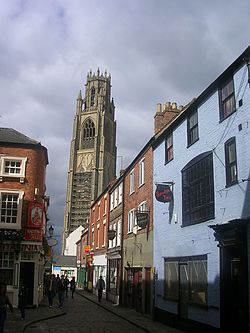 Boston | |
| Location | |
| Grid reference: | TF329437 |
| Location: | 52°58’29"N, 0°1’17"W |
| Data | |
| Population: | 58,124 |
| Post town: | Boston |
| Postcode: | PE21 |
| Dialling code: | 01205 |
| Local Government | |
| Council: | Boston |
| Parliamentary constituency: |
Boston and Skegness |
Boston is a port town in Lincolnshire. It is the major town of Holland, the south-eastern part of that county. Boston lies astride the Greenwich Meridian.
Boston's most notable landmark is St Botolph's Church (The Stump), the largest parish church in Britain[1] with one of the highest towers, visible in the flat lands of Lincolnshire for many miles. Residents of Boston are known as Bostonians. Emigrants from Boston named several other settlements after the town, most notably Boston, Massachusetts.
Boston was once a major port serving primarily the Baltic trade. Today however the port is much declined, and ships sail to nearby Sutton Bridge which has modern port facilities and a deep water haven suitable to modern ships,[2] or to the major ports of the Humber.
Churches
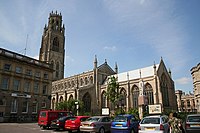
- Church of England:
- Baptist: Boston Baptist Church
- Independent: Boston Christian Fellowship
- Methodist:
- New Life Fellowship: New Life Fellowship, Kirton
- Salvation Army: Boston Citadel
History
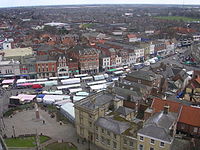
Name
The name Boston is believed to be a contraction of St Botolph's town. It was long accepted that Boston was the place known as Icanho in which St Botolph established a monastery in the year 654. However, mmore recent historians have concluded that Botolph's establishment was likely to have been in Suffolk, perhaps at Iken. However, Botolph was a popular missionary, to whom many churches between Yorkshire and Sussex are dedicated, including that of Boston.
Early history
The Domesday Book of 1086, does not mention Boston by name. However, the settlement of Skirbeck is covered, as part of the very wealthy manor of Drayton. Skirbeck had two churches and one is likely to have been that dedicated to St Botolph, in what was consequently Botolph's town. If once Boston was an area of Skirbeck, now Skirbeck (TF339433), is considered part of Boston.
Skirbeck developed at the head of the Haven, which lies under the present Market Place. At that stage, The Haven was the tidal part of the stream, now represented by the Stone Bridge Drain), which carried the water from the East and West Fens. The line of the road through Wide Bargate, to A52 and A16 roads, is likely to have developed on its marine silt levees. It led, as it does now, to the relatively high ground at (Sibsey), and thence to Lindsey.
The reason for the development of the town at its current centre not at Skirbeck is found in the coming together of transport routes. Boston lies where navigable tidal water is met by the long-distance roads, which use the moraine ridge at Sibsey, between the upland of East Lindsey and the three routes to the south of Boston:
- The coastal route, on the marine silts, crossed the mouth of Bicker Haven towards Spalding.
- The Sleaford route, into Kesteven, passing by way of Swineshead, and thence following the old course of the River Slea, on its marine silt levee.
- The Salters' Way route into Kesteven, left Holland from Donington.
The River Witham seems to have joined The Haven after the flood of September, 1014, having abandoned the port of Drayton, on what subsequently became known as Bicker Haven. The predecessor of Ralph the Staller owned most of both Skirbeck and Drayton, so it was a relatively simple task to transfer his business from Drayton, but Domesday Book of 1086, still records his source of income in Boston under the heading of Drayton, so Boston's name is famously not mentioned. The Town Bridge still maintains the pre-flood route, along the old Haven bank.
Growth
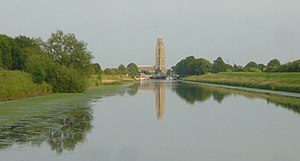
After the Norman Conquest of 1066, Ralph the Staller's property was taken over by Count Alan. It subsequently came to be attached to the Earldom of Richmond and known as the Richmond Fee. It lay on the left bank of The Haven.
During the eleventh and twelfth centuries, Boston grew into a notable town and port, shown by the receipts for quinzieme (a duty raised on the fifteenth part of the value of merchants' moveable goods); in 1204 the merchants of London paid £836, and those of Boston paid £780.
Thus by the opening of the thirteenth century, Boston was already significant in trade with Europe and ranked as a port of the Hanseatic League. It was one of the official "staple towns" of England, authorized to carry on the import and export trade in wool. Much of Boston's trade at this time was indeed wool, and Boston is said by the locals to have been built on it. Apart from wool, Boston also exported salt, produced locally on the Holland coast, grain, produced up-river and lead, produced in Derbyshire and brought by way of Lincoln, up-river on the Witham. The wool export trade began to decline in the fifteenth century as the industry shifted to the business of weaving, which was conducted in other parts of the country. The Hansa merchants left the town, and Boston's wealth declined.
In the thirteenth and fourteenth centuries four orders of friars arrived in Boston: Dominicans, Franciscans, Carmelites, and Augustinians. At the Reformation, their friaries were closed by King Henry VIII. The refectory of the Dominican friary was eventually converted into a theatre in 1965, and now houses the Blackfriars Arts Centre.
The town received its charter from Henry VIII in 1545 and from 1552 until the Reform Act 1832 Boston returned two Members to Parliament. However, the Haven had begun to silt up and the town was declining.
17th and 18th centuries
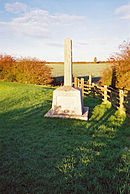
In 1607 a group of pilgrims from Nottinghamshire led by William Brewster and William Bradford attempted to escape pressure to conform to the teaching of the English church by going to the Netherlands from Boston. At that time unsanctioned emigration was illegal, and they were brought before the court in the Guildhall. Most of the pilgrims were released fairly soon and the following year, set sail for the Netherlands, settling in Leiden. In 1620, several of these were among the group who moved to New England in the Mayflower.
Boston remained a hotbed of religious dissent. In 1612 John Cotton became the Vicar of St Botolph's and, although viewed askance by the Church of England for his non-conformist preaching, became responsible for a large increase in Church attendance. He encouraged those who disliked the lack of religious freedom in England to join the Massachusetts Bay Company, and later helped to found the city of Boston, Massachusetts (1630) which he was instrumental in naming. Unable to tolerate the religious situation any longer, he eventually emigrated himself in 1633.
At the same time, work on draining the fens to the west of Boston was begun, a scheme which displeased many whose livelihoods were at risk. (One of the sources of livelihood obtained from the fen was fowling, supplying ducks and geese for meat and in addition the processing of their feathers and down for use in mattresses and pillows. The feathery aspect of this is still reflected in the presence of the bedding company named Fogarty, located nearby in Fishtoft.) This and the religious friction put Boston into the parliamentarian camp in the Civil War which in England began in 1642. The chief backer of the drainage locally, Lord Lindsey, was shot in the first battle and the fens returned to their accustomed dampness until after 1750.
The later eighteenth century saw a revival when the Fens began to be effectively drained. The Act of Parliament permitting the embanking and straightening of the fenland Witham was dated 1762. A sluice, called for in the Act, was designed to help scour out The Haven. The land proved to be fertile, and Boston began exporting cereals to London. In 1774 the first financial bank was opened, and in 1776 an Act of Parliament allowed watchmen to begin patrolling the streets at night.
Modern history
In the nineteenth century, the names of Howden, a firm located near the Grand Sluice and Tuxford, near the Maud Foster Sluice, were respected among engineers for their steam road locomotives, threshing engines and the like. Howden developed his business from making steam engines for river boats while Tuxford began as a miller and millwright. His mill was once prominent near Skirbeck Church, just to the east of the Maud Foster Drain.
The railway reached the town in 1848 and briefly, it was on the main line from London to the North. The area between the Black Sluice and the railway station was mainly railway yard and the railway company's main depôt. The latter facility moved to Doncaster when the modern main line was opened. Boston remained something of a local railway hub well into the twentieth century, moving the produce of the district and the trade of the dock, plus the excursion trade to Skegness and similar places, but it was much quieter by the time of the Beeching axe of the 1960s.
Boston once again became a significant port in trade and fishing when, in 1884, the new dock with its associated wharves on The Haven were constructed. It continued as a working port, exporting grain, fertilizer, and importing timber although much of the fishing trade was moved out in the inter-war period. During the First World War many of the town's trawlermen, together with those from Grimsby, were taken prisoner after their ships were sunk by German raiders in the North Sea. Their families did not know what had happened to them till late September 1914. The men were taken to Sennelager camp then on to Ruhleben POW camp where most remained till repatriated in 1918. There is a full report of their homecoming in the Lincolnshire Standard newspaper, January 1918.
The first cinema opened in 1910, and the town was used by film makers during the First World War to represent the Netherlands when the real thing was not available for filming. In 1913 a new Town Bridge was constructed. Central Park was purchased in 1919, and is now one of the focal points of the town. Electricity came to Boston during the early part of the century, and electrical street lighting was provided from 1924.
The Haven Bridge, which now carries the two trunk roads over the river was opened in 1963 and the new road built in the early 1970s rather separated Skirbeck from Boston but the town largely avoided the development boom of the 1960s. More recently, the new shopping centre named the Pescod Centre opened in 2004, bringing many new shops into the town. Further development is planned.
The town has experienced a decline in recent years both economically and in terms of its reputation. Exacerbated by the decline of farming, the town's traditional role as a service centre for the surrounding agricultural region has been eroded. Many retail businesses in the town are struggling at present and several have closed.
People
According to the 2001 census, there were 35,124 people residing in Boston town, of whom 48.2% were male and 51.8% were female. Children under five accounted for approximately 5% of the population. 23% of the resident population in Boston were of retirement age.
In 2006 Boston was shown to have the highest obesity rate of any town in the United Kingdom. Figures showed that 31% of adults in the town were clinically obese. Six out of seven people fail to hit the target of three half-hour sessions a week of moderate intensity sport or active recreation. This obesity has been linked to social deprivation.[3]
The town has a large immigrant population, mostly from Eastern Europe and Portugal. This has led to some social tension, which came to a head during the 2004 European Football Championship, when something akin to rioting[4] broke out briefly: windows were smashed and shops looted, police cars overturned and set alight. Trouble once again erupted in the town, when the England team was knocked out of the 2006 World Cup by Portugal, and there were clashes between riot police and fans from England and Portugal. Some pubs and bars in the area were vandalised, windows smashed and tables, chairs and glasses thrown at rival fans, riot police and shops and bars. The local Portuguese bar, 'The Volunteer', was attacked by British youths, who threw missiles, smashed windows and were in possession of petrol bombs. The youths surrounded the bar and trapped the Portuguese supporters inside. Riot police broke the situation up soon after.
However, as a sea port and holder of trade fairs, the town was long accustomed to seamen from the Baltic, Hansa merchants and others. After the surrounding land was drained, there were influxes of seasonal labourers from other parts of Britain and from Europe. People occasionally became excited then too - the Hansa merchants finally left after one had been in a fight. But the fights are noticed because of their rarity.
Landmarks
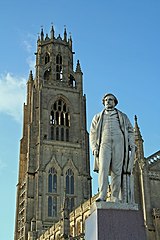
Some of the most interesting things to be seen in Boston lie not in the usual list of tourist features, but in the area of civil engineering. However, there are remarkable sights of the more usual sort:
The parish church of Saint Botolph is known locally as The Stump and is renowned for its lantern interior and 52 misericords.
The Grand Sluice is disguised by railway and road bridges, but it is there, keeping the tide out of the Fens and twice a day, allowing the water from the upland to scour the Haven. Not far away, in the opposite direction, was the boyhood home of John Foxe, the author of Foxe's Book of Martyrs.
The Town Bridge honours the line of the road to Lindsey and from its western end, looking at the river side of the Exchange Building to the right, it is possible to see how the two ends of the building, founded on the natural levees of The Haven, have stood firm while the middle has sunk into the infill of the former river.
From 1552, the Bostonians used to have their gaol near The Stump, and this is likely to be where the Scrooby Pilgrims were imprisoned in 1607. The lawyers' quarter is still in use, just to the north of the church.
A statue of the founder of The Illustrated London News, Herbert Ingram now stands in front of The Stump. The statue was designed by Alexander Munro and was unveiled in October, 1862. The allegorical figure, at the base of the monument, is a reference to Ingram's efforts to bring the first piped water to the town. He was also instrumental in bringing the railways to Boston. Born in nearby Swineshead, he was also MP for Boston, from 1856, until his death in 1860, in a shipping accident on Lake Michigan.
The market, held on Saturdays and Wednesdays, in the Market Place and also on Wide Bargate on Wednesday. Market Place and Strait Bargate are the retail hub of the town centre.
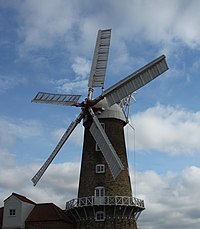
The seven-storeyed Maud Foster Tower Windmill, completed in 1819, by millwrights Norman & Smithson of Kingston upon Hull for Issac and Thomas Reckitt, is momentarily the tallest operating windmill in England (80 ft to the top of the cap), following extensive restoration during the 1980s and early 1990s and is now a working museum. The tall mill, without the usual tar coating in Lincs, stands on the dyke above the drain it is named after and is unusual in having an odd number (five) of sails.
The Boston Guildhall in which the Pilgrim Fathers were tried, on the first floor, by the magistrates, was converted into a museum in 1929. The American Room was opened by the American Ambassador, Joseph P Kennedy, Sr., in 1938. The cells in which the pilgrims are said to have been held at the time of their trial are on the ground floor. In 2005 it is closed for repair and refurbishment. - The Pilgrim Fathers Memorial is found on the north bank of The Haven a few miles outside the town. It was here at Scotia Creek, that the pilgrims made their first attempt to leave for the Netherlands in 1607.
In Skirbeck Quarter, on the right bank of The Haven, is the Black Sluice, the outfall of the South Forty-Foot Drain.
The Greenwich Meridian passes through the eastern side of Boston, marked by the fairly modern, suburban Meridian Road, which straddles the line after which the road was named.
The oldest landmark is the Boston May Fair which has been held in the town every year since at least 1125. This fair is held during the first week of May, and is one of the largest outdoor fairs in the country. By tradition, the fair was officially opened by the incumbent mayor at 11 am on the May Day bank holiday, a tradition no longer followed.
The Haven Gallery, opened in 2005, was closed to the public in 2010 in a costcutting measure by the council.
Freiston Shore is a nature reserve, and lies on The Wash coast north of the mouth of The Haven.
References
- ↑ "Church sells bits of Boston Stump". BBC News. 3 November 2005. http://news.bbc.co.uk/1/hi/england/lincolnshire/4403100.stm. Retrieved 18 August 2009.
- ↑ Simon Group: Port Sutton Bridge
- ↑ Carter, Helen (2006-10-12). "Lincolnshire: home of the porker?". London: The Guardian. http://www.guardian.co.uk/medicine/story/0,,1920152,00.html. Retrieved 2007-07-30.
- ↑ "England | Lincolnshire | Three charged after Boston 'riot'". BBC News. 2004-06-15. http://news.bbc.co.uk/1/hi/england/lincolnshire/3810213.stm. Retrieved 2009-03-15.
- Morris, J. ed. Domesday Book Vol. 31, Lincolnshire Parts 1 & 2. Chichester. (1986) ISBN 0-85033-598-1.
- Thompson, P. The History and Antiquities of Boston etc. Boston, London & Boston Mass. (1856). facsimile edn. (1997) ISBN 0-948639-20-2.